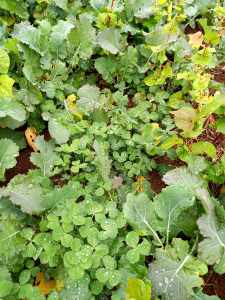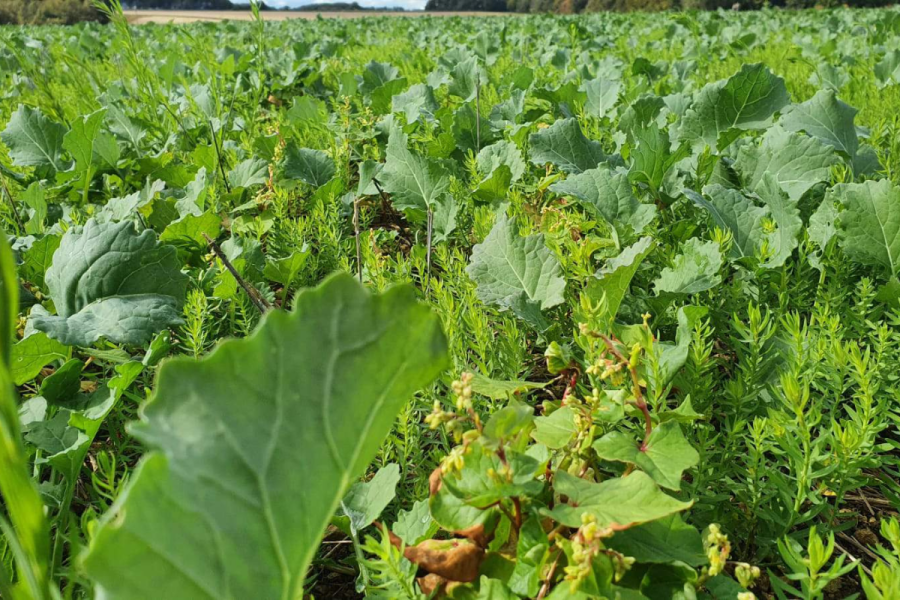When considering planting a companion crop with oilseed rape, it’s important that it will help and not hinder the cash crop. CPM explores the nuances of selecting the right species for the situation.
“I wouldn’t contemplate growing OSR without companion crops now as it brings so many benefits to establishment and the system.”
By Melanie Jenkins
Companion crops are increasingly being utilised alongside oilseed rape to help the brassica combat pests, improve rooting and scavenge nutrients. But each farm is unique, so tailoring any decisions to the situation is of vital importance.
For Steve Corbett of Agrii, whether or not to plant a companion crop hinges around soil type, conditions and moisture content and he advises approaching the decision with purpose while being clear about the objectives.

Growing a companion crop can add £30-£40/ha in cost of production, so selecting the right species and variety can make all the difference, says Steve Corbett.
“You can soon add £30-£40/ha in cost of production when growing a companion crop, so selecting the right species and variety can make all the difference.”
As a brassica, OSR is a lazy rooter, so soil structure is critical in allowing roots to extend up to 1-2m deep and be optimally efficient, he explains. “If there are any compacted zones in the soil, OSR roots will travel laterally which can compromise yield and nutrient use efficiency. And if soils dry up and the crop runs out of water, a shallower rooted crop won’t be taking up nutrients, which is why it’s critical to get the growing medium right.”
So this is one way companion crops can help, says Steve. “Certain companion species can penetrate more compact soil zones, allowing OSR to follow the roots through. Vetches have a very good rooting system so are a useful companion in instances where you’re trying to encourage deeper rooting.”
In situations where friability in the shallower soil profile requires improving, phacelia’s fibrous, shallow roots can help, says Steve.
“Linseed and berseem clover also have strong, powerful roots which can aid establishment, with the latter also adding a little N to the system. But berseem clover can be difficult to grow on heavy soils and is quite expensive, plus pea and bean weevil can be an issue, meaning it’s vulnerable at emergence.”
Buckwheat can also be grown as a shallower rooting companion crop that will scavenge for nutrients, but it’s essential to select the appropriate variety for the situation. He believes buckwheat’s main advantage is to help provide cover for establishing OSR plants, hiding them from migrating CSFB, but says it can prove hard to establish on heavy land.
John Vickery of Agrii agrees, adding that buckwheat’s fast growth habit means it shoots up above most stubbles ahead of the emerging OSR. “However, this isn’t a fool proof solution as there has to be moisture and a bit of luck.”
As well as foiling CSFB, buckwheat mines phosphate, pulling it from the soil pool to make it available for the OSR crop. It’s also beneficial from a mycorrhizal perspective, he says.
Fenugreek is another companion species which can be used to help deter CSFB as it’s believed to emit a curry-like aroma. He also notes that there’s a fine line between a companion species working with the crop and working against it, effectively becoming a weed.
“I used Fenugreek as a companion crop at a site in Lincolnshire, where it was planted two weeks prior to the OSR, and it established so well that it smothered the brassica completely. So caution is required because on rare occasions OSR can be outcompeted.”
A further consideration could be N-fixing ability, says Steve. “When prices were high, many were looking at semi-permanent covers, such as small leaf white clover. These can be undersown into oats or spring barley, but keep in mind clover is harder to drill OSR into and you have to get the density right, otherwise it’s too competitive with your cash crop.”

When nitrogen prices were high, semi-permanent covers, such as small leaf white clover, were being grown for their N-fixing ability.
John likes to use purple vetch as it provides both soil structure and nitrogen fixation. It can also create cover in the gaps where pigeons could otherwise land.
One tactic to help prevent competition is to set OSR row widths to 25cm so that a companion crop can sit between the rows, he explains. “Also consider seed rate. For example, phacelia can be drilled anywhere from 0.5kg/ha to 2kg/ha and vetch can be planted at 3-5kg/ha, depending on soil type and moisture.
“Alternatively, you could strip till – only cultivating where the OSR is going in and then put the companion crop alongside it, but I’d suggest working closely with your agronomist to determine what’s best for your situation.”
Steve advises keeping in mind that establishing OSR on heavy soils can be difficult and it’s equally hard to establish a companion crop, especially in a dry season when the companion might take moisture away from the OSR.
“In this situation you could end up wasting more money by attempting to grow a companion. And if you’ve got a lot of straw debris, such as after winter barley, and the chaff hasn’t been spread well enough, this can kill the companion crop. So just keep this in mind,” he warns.
John has found the first half of August the best time to drill a companion crop. “This is generally the most successful slot, but the caveat is that there has to be moisture for seeds to germinate, so the timing is everything.”
Starter fertiliser is all part of the story with companion crops, says Steve. “As well as aiding the OSR, this will help kick start the companion crop too.”
Once a companion crop has been established, the next consideration is herbicide applications, says Steve. Graminicides can be applied to control volunteers or blackgrass without issue but when it comes to broadleaf weed herbicides, the timing has to coincide with the best time for removal of the companion crop.
John highlights that although some species may be killed by cold weather, often this isn’t the case. “Vetches aren’t supposed to be able to tolerate the coldest weather, but they invariable do, but either Astrokerb (propyzamide+ aminopyralid) or Belkar (Arylex+ picloram) can be used to take them out. Leave vetch in as long as possible – until January – and once destroyed it’ll release N throughout the spring.”
Buckwheat will die off in cold weather or in frosts and so doesn’t have to be destroyed, he says. “Generally, by mid-November you’ll see it start to keel over and it’ll be gone by Christmas.”
It’s also possible to leave companion crops and not destroy them, says Steve. “I have growers who’ve left vetch and phacelia and the OSR has performed just a well as when the companions have been taken out. But be warned, this looks horrendous and a bit scary, and is only really suitable in low broadleaf weed pressure situations.”
This article was taken from the latest issue of CPM. Read the article in full here.
For more articles like this, subscribe here.
Sign up for Crop Production Magazine’s FREE e-newsletter here.




